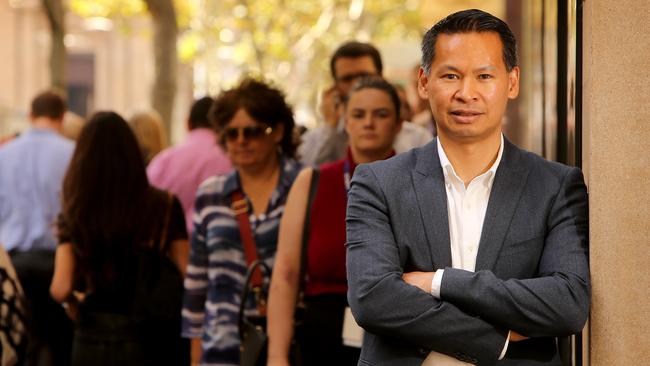Diversity turns to culture
Companies are waking up to the lackof Asian representation on their boards.

Gender diversity is gaining traction at a glacial pace in big business as more women speak out about the benefits they bring to the corporate suite.
But experts say attention now needs to turn to the cultural mix — or lack of it — at executive level, with growing calls for greater Asian representation.
The number of Asian board members is frighteningly low.
A 2013 Diversity Council of Australia study found only 4 per cent of ASX 200 companies had Asian representation at a senior executive level.
Online currency transfer company WorldRemit Asia Pacific director Michael Liu describes those statistics as “damning”.
Liu, whose parents were born in China, says people with Asian backgrounds can help businesses perform better by improving diversity of thought.
“Most organisations now have people with Asian backgrounds at junior levels, it’s a matter of time,” he says.
Liu blames unconscious bias for the lack of cultural diversity at executive level, and says while Australia was founded on the idea of mateship and giving people a fair go, that can be difficult to achieve at the top.
“When people recruit they often try and pick people who look, sound and think like them — it may be education, they’re finding people like them, it may be unconscious bias,” he says.
“One way of eliminating unconscious bias is to show commercially and financially why it’s profitable and financially beneficial to have a diverse company. You can show a company will make more profit or be more successful with better diversity.”
Concerns about cultural diversity were raised recently in an Australian Human Resources Institute report questioning whether Asian workers were dissatisfied with their career prospects, with 80 per cent responding in the negative. The report pointed to a Canadian study that found people with Asian names were 28 per cent less likely to secure an interview when applying for jobs.
The DCA has blamed the nation’s Westernised leadership model for the poor statistics, with a common stereotype that Asian-born workers lacked ambition not helping the cause.
DCA chief executive Lisa Annese says the best way to improve diversity is to increase the definitions of leadership, so people can be who they are without fitting a narrow, Westernised stereotype.
Lui says understanding how Asian businesses operate is crucial, and having senior executives engaging with staff who may have a better understanding of cultural differences can help.
WorldRemit employs about 350 people, and 35 nationalities are represented..
Working cohesively is also important, Lui says, including ensuring executives communicate with all staff and hear the diversity of views on offer.
Telstra human resources group executive Alex Badenoch can see change happening at the board level in gender and cultural diversity but says the pace is slow and more needs to be done.
“Australian businesses need to step up more strongly to this conversation and go beyond conversation to action,” Badenoch says. “We are still not world-leading in terms of our real reflection of diversity of employment, and gender is often the one that gets pulled out because it is still one of the most visible ones — it is very easy to measure, track and monitor. For broader cultural diversity we rely heavily on people self-reporting and self-identification because it’s not always obvious.”
Telstra has a gender diversity target of 40 per cent, and is now sitting at about 30 per cent.
Badenoch says the company will not appoint women based on gender or people with ethnic backgrounds to ensure diversity, but it has tried to level the playing field. She says the company has set a target of having an equal gender split of job candidates, and to do so she ensures job specifications are worded so as not to exclude women — such as calling for 20 years’ experience when women may have had career breaks — and ensuring equal numbers are interviewed.
It also means encouraging women into technical and engineering roles from an early age through education programs and setting an example that women can work in any job they choose.
The company can’t specify board roles go to people of ethnically diverse backgrounds, but she says Telstra has a strong focus on training staff in Southeast Asia and ensuring they have opportunities through training programs and internships, and in positions in Australia. It also has a commitment to transitioning all offshore management positions to locals.
Despite not having any Asian-born directors on the board, Badenoch sees their role as a positive. It should not be forced discrimination, as boards need representation that suits their business interests at any given time.
“We can’t deny the very close and important link of doing business in Asia; having representatives on board who know those markets, who understand what’s happening at a much more intimate level than you do as an observer from Australia, has to be a positive,” she says.
Cloud consulting firm Bluewolf’s Australian managing director, Aniqa Tariq, is the definition of diversity. With a Turkish background, she was born in Canada, grew up in the US and has lived in Switzerland, Hong Kong, Germany and now Australia. She speaks three languages.
“I’ve probably had so many marks against me: I’m short, I’m female, I have a different name, I have brown skin colour — and I didn’t let that hold me back, I tried to be great at what I did,” she says.
Tariq says diversity shouldn’t be about increasing Asian participation on boards but about allowing people to be themselves, inclusivity, and promoting diverse thoughts and experiences.


